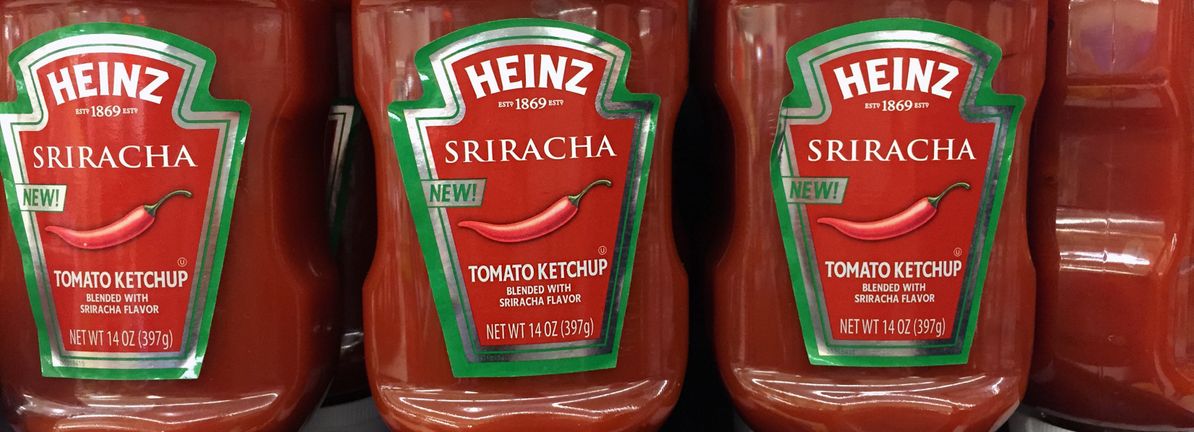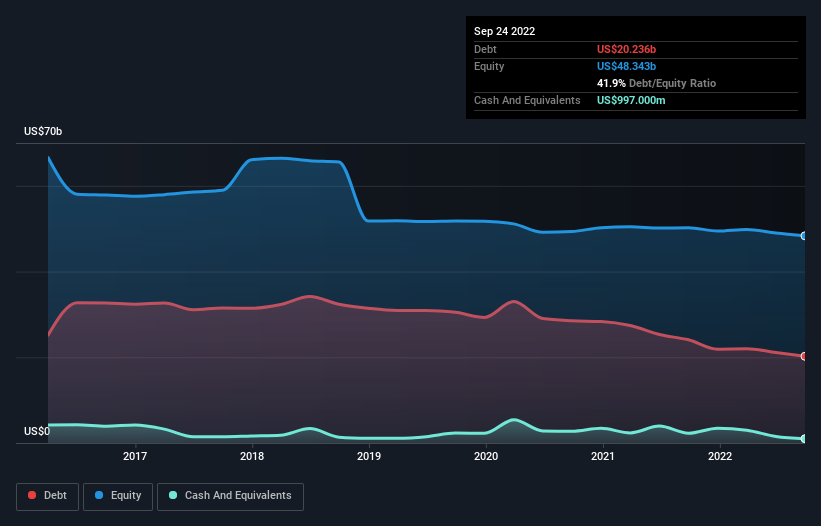
Howard Marks put it nicely when he said that, rather than worrying about share price volatility, ‘The possibility of permanent loss is the risk I worry about… and every practical investor I know worries about.’ So it might be obvious that you need to consider debt, when you think about how risky any given stock is, because too much debt can sink a company. We note that The Kraft Heinz Company (NASDAQ:KHC) does have debt on its balance sheet. But the more important question is: how much risk is that debt creating?
When Is Debt A Problem?
Debt assists a business until the business has trouble paying it off, either with new capital or with free cash flow. In the worst case scenario, a company can go bankrupt if it cannot pay its creditors. However, a more frequent (but still costly) occurrence is where a company must issue shares at bargain-basement prices, permanently diluting shareholders, just to shore up its balance sheet. Of course, debt can be an important tool in businesses, particularly capital heavy businesses. When we think about a company’s use of debt, we first look at cash and debt together.
Check out our latest analysis for Kraft Heinz
What Is Kraft Heinz’s Debt?
You can click the graphic below for the historical numbers, but it shows that Kraft Heinz had US$20.2b of debt in September 2022, down from US$24.1b, one year before. However, it does have US$997.0m in cash offsetting this, leading to net debt of about US$19.2b.

How Healthy Is Kraft Heinz’s Balance Sheet?
According to the last reported balance sheet, Kraft Heinz had liabilities of US$8.69b due within 12 months, and liabilities of US$33.0b due beyond 12 months. Offsetting these obligations, it had cash of US$997.0m as well as receivables valued at US$2.06b due within 12 months. So its liabilities outweigh the sum of its cash and (near-term) receivables by US$38.6b.
This is a mountain of leverage even relative to its gargantuan market capitalization of US$52.2b. This suggests shareholders would be heavily diluted if the company needed to shore up its balance sheet in a hurry.
We measure a company’s debt load relative to its earnings power by looking at its net debt divided by its earnings before interest, tax, depreciation, and amortization (EBITDA) and by calculating how easily its earnings before interest and tax (EBIT) cover its interest expense (interest cover). Thus we consider debt relative to earnings both with and without depreciation and amortization expenses.
Kraft Heinz’s debt is 3.3 times its EBITDA, and its EBIT cover its interest expense 3.8 times over. This suggests that while the debt levels are significant, we’d stop short of calling them problematic. Another concern for investors might be that Kraft Heinz’s EBIT fell 15% in the last year. If that’s the way things keep going handling the debt load will be like delivering hot coffees on a pogo stick. The balance sheet is clearly the area to focus on when you are analysing debt. But ultimately the future profitability of the business will decide if Kraft Heinz can strengthen its balance sheet over time. So if you want to see what the professionals think, you might find this free report on analyst profit forecasts to be interesting.
Finally, a business needs free cash flow to pay off debt; accounting profits just don’t cut it. So we clearly need to look at whether that EBIT is leading to corresponding free cash flow. Over the most recent three years, Kraft Heinz recorded free cash flow worth 67% of its EBIT, which is around normal, given free cash flow excludes interest and tax. This free cash flow puts the company in a good position to pay down debt, when appropriate.
Our View
We’d go so far as to say Kraft Heinz’s EBIT growth rate was disappointing. But on the bright side, its conversion of EBIT to free cash flow is a good sign, and makes us more optimistic. Once we consider all the factors above, together, it seems to us that Kraft Heinz’s debt is making it a bit risky. That’s not necessarily a bad thing, but we’d generally feel more comfortable with less leverage. There’s no doubt that we learn most about debt from the balance sheet. But ultimately, every company can contain risks that exist outside of the balance sheet. These risks can be hard to spot. Every company has them, and we’ve spotted 3 warning signs for Kraft Heinz you should know about.
At the end of the day, it’s often better to focus on companies that are free from net debt. You can access our special list of such companies (all with a track record of profit growth). It’s free.
What are the risks and opportunities for Kraft Heinz?
The Kraft Heinz Company, together with its subsidiaries, manufactures and markets food and beverage products in the United States, Canada, the United Kingdom, and internationally.
Rewards
-
Trading at 49.1% below our estimate of its fair value
-
Earnings are forecast to grow 13.17% per year
Risks
-
Profit margins (4.7%) are lower than last year (8.8%)
-
Large one-off items impacting financial results
Have feedback on this article? Concerned about the content? Get in touch with us directly. Alternatively, email editorial-team (at) simplywallst.com.
This article by Simply Wall St is general in nature. We provide commentary based on historical data and analyst forecasts only using an unbiased methodology and our articles are not intended to be financial advice. It does not constitute a recommendation to buy or sell any stock, and does not take account of your objectives, or your financial situation. We aim to bring you long-term focused analysis driven by fundamental data. Note that our analysis may not factor in the latest price-sensitive company announcements or qualitative material. Simply Wall St has no position in any stocks mentioned.
Source link
